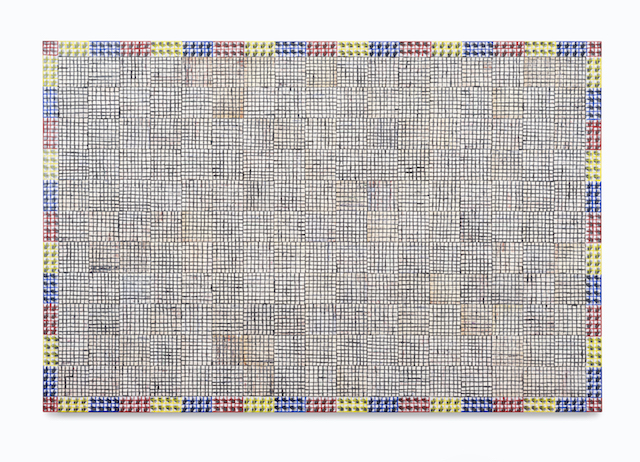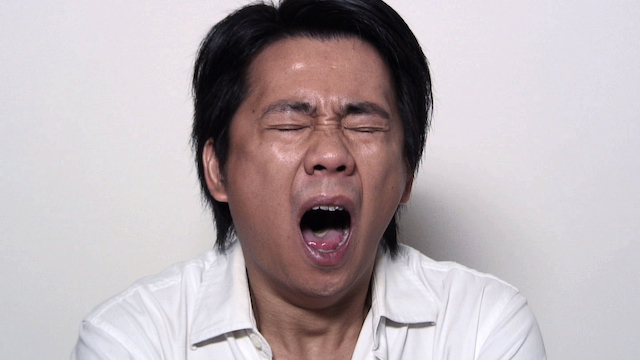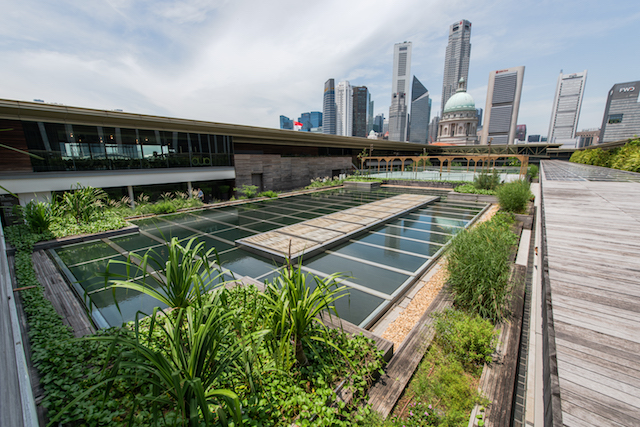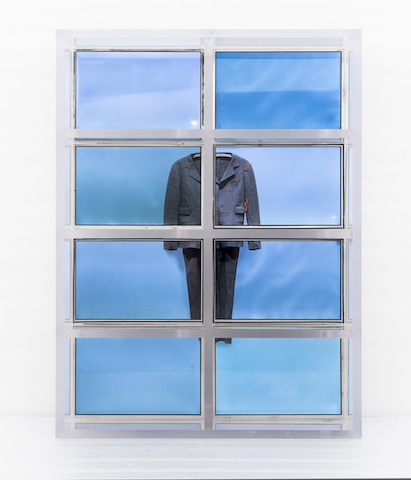MURAKAMI vs MURAKAMI, 2019 (installation view, Tai Kwun, Hong Kong). © Takashi Murakami/Kaikai Kiki Co Ltd, All Rights Reserved, 2019
Takashi Murakami at Tai Kwun Contemporary, Hong Kong, through 1 September
Avalokiteśvara is the bodhisattva of compassion, looking out for and reaching out to those in need. That so many need to be heard caused his or her (Avalokiteśvara takes both genders) head to split into 11, so that she could better hear their cries. That so many needed her help caused his two arms to shatter, whereupon she was given 1,000 so that he could make a better fist of things. She can take on other forms too, but you get the drift.
Takashi Murakami’s 2012 sculpture Split is monstrous, a hyperreal self-portrait in which the artist (dressed as an ogre-priest) has apparently split his face in two. He has done this in order to peel off his outer skin (which seems to be a rather thick and leathery dermis) and reveal his identical (though presumably slightly smaller) inner face poking out from the two halves of its predecessor. His new eyes swivel; the old ones, one on the outer side of each of the new ones, give the impression that he now has three heads. While Japan’s most popular artist has been engaging with religious iconography over the past few years, it’s unclear whether Split has anything to do with compassion (Murakami’s sculpture is based on a Heinan-era sculpture at the Saionji Temple in Kyoto), but he’s certainly everywhere at the moment. Not least in the adaptation of Split used to create a portrait of American pop star Billie Eilish early this year and Murakami’s directing of the anime-style video for her 2018 song You Should See Me in a Crown. Back in the world of unpopular culture, this month sees the opening of the artist’s latest solo exhibition at Hong Kong’s Tai Kwun Contemporary. Murakami vs Murakami offers a comprehensive overview of the artist’s output, from the kawaii flower paintings to his explorations of the iconography of enlightenment. His costume designs will be on show too, alongside a sampling of works from the artist’s private collection in what promises to be an insight into Murakami’s many selves. And he’s not the only one offering that.

McArthur Binion at Massimo de Carlo, Hong Kong, through 31 August / Lehmann Maupin, Hong Kong, through 5 July / Lehmann Maupin Seoul, through 13 July
Elsewhere in the Special Administrative Region, the work of seventy-three-year-old American McArthur Binion is split across two galleries in the Pedder Building (Lehmann Maupin and Massimo De Carlo), as well as a third space in Seoul (Lehmann Maupin’s other Asia outpost). Born in Mississippi, brought up in Detroit, trained at Cranbrook, Binion spent the 1970s and 80s in New York, working alongside artists such as Jean-Michel Basquiat, Sol LeWitt and Brice Marden, before moving to Chicago during the 1990s. His work shifted from gestural and geometric abstraction to a form of collage incorporating hand-painted grids and notionally private materials such as birth certificates and address books, which generated a unique form of personalised abstraction both anticipating and resisting a big-data age. Perhaps it’s a subtler way of telling the world about your many selves.

Matter and Place at Museum MACAN, Jakarta, through 21 July
Identity, of course, is constructed in many ways and at Museum MACAN in Jakarta it’s the role of place and our perception of it as a driver for identity formation that takes centre stage. Matter and Place is a group exhibition (featuring works by Danh Vō, FX Harsono, Genevieve Chua and Theaster Gates drawn from MACAN’s collection) based around two new works: Indonesian architect Andra Matin presents an installation featuring a spiral staircase made of Jabon wood that explores the ways in which various traditional domestic architectures have informed Indonesia’s ways of living; while Malaysia-based Shooshie Sulaiman’s Tadika Getah (Rubber Kindergarten, 2019) continues the artist’s exploration of a childhood spent playing on her father’s rubber plantation and the relationship of the material to her own, Malaysia’s and Southeast Asia’s social and cultural development.

Healthier, Simpler, Wiser at Edouard Malingue Gallery, Shanghai, through 30 June
Traditional construction techniques have also provided the inspiration for Hu Xiangqian, whose latest work, on show as part of the group exhibition Healthier, Simpler, Wiser, at Edouard Malingue Gallery Hong Kong, is inspired by Internet videos of people building houses with traditional methods. Hu describes watching such documentaries as a ‘personal interest’, and his work is based around performance (Blue Flag Waving, 2006, for example, documented Hu’s real-life election campaign for a seat in his hometown, though the artist was never an eligible candidate), often recorded on video in a crude manner. Hu’s life to date has been migrant. Born in Guangdong, he later moved to New York and is currently in Beijing. With typical perversity, he says he has never had any interest in building his own home and doesn’t even keep the places in which he lives tidy. Naturally he’s going to be building a structure in the gallery, where he’ll be showing alongside Kwan Sheung Chi and Lai Chih-Sheng, both from Hong Kong.

Peter Peri at Pearl Lam Galleries, Hong Kong, through 30 August
Dwellings also play a role in British artist Peter Peri’s latest exhibition at Pearl Lam Galleries Hong Kong. The exhibition is titled Quarters and plays with the double meaning of the word in terms of a division of a whole and a militaristic description of living space. More directly Peri, whose oeuvre is broken into discrete bodies of work, each executed in a different medium (painting, sculpture and drawing), relates it to the phases of the moon. Here, the paintings will refer to the idea of dwelling and mathematical division, the sculptures will reflect on the human presence and the drawings the act of looking.

Charles Lim Yi Yong at National Gallery Singapore, through 27 October
It is, however, gardening rather than building that informs Charles Lim’s new installation at the National Gallery Singapore. Following Rirkrit Tiravanija and Danh Vō, Singapore’s representative at the 2015 Venice Biennale is the latest artist to present a site-specific installation on the roof of the institution. Sea State 9: proclamation garden (2019) is part of an evolving project which focuses on Singapore’s relationship to the sea in terms of processes of land reclamation, natural resources and geographical boundaries. Singapore has increased its landmass by 22 percent in the 54 years since it gained independence. Lim has transformed the Gallery’s rooftop into a garden composed of plants found on reclaimed land from Changi to Tuas and the Southern Islands, to present an exploration of the city state’s natural and unnatural development since its foundation.

Guangzhou Airport Biennale at Guangzhou Wing Kong Airport Town, through 31 August
Every place seems to be hosting some sort of biennale these days, so it’s only natural that curators should now move on to populate nonplaces with them. As the French anthropologist Marc Augé has it, nonplaces are the kind of spaces that lack any obvious residents or any reason for people passing through to do anything but that: spaces like motorways, hotel rooms and airports. OK, so the first Guangzhou Airport Biennale doesn’t actually take place within the airport (it’s more accurately within its locale, in Fenghe Village, which is described as an ‘airport-themed town full of rich resources’, mainly catering to those working at or passing through the airport) but, intriguingly, it does aim to give a sense of place to an area without one. Featuring 81 Chinese and international artists (among them Olafur Eliasson and Yayoi Kusama) and titled Extreme Mix, it aims to go about its work by combining local folk culture with international contemporary art. With leading artists Xu Zhen and Fan Bo onboard as cultural advisers, the exhibition promises to be an interesting mix of the comic and the profound.

SUPERFLEX at Kukje Gallery Busan
In any case, you’re going to need the airport to get to Busan, where, at Kukje Gallery, Danish collective SUPERFLEX are exploring another nonplace: the bank. Moreover, they will be showing a new iteration of their series Bankrupt Banks (2008–), which documents the logos of financial institutions that have gone bankrupt or been taken over by other entities since the onset of the financial crisis in 2008. The painted logos offer an empty language that was designed to convey stability and power, and a map of the reconfiguration of global banking in the wake of its general failure. Alongside that will be versions of Connect With Me (2018), a series of tubular sculptures that document the rise and fall in value of bitcoin, and that, as works of art, offer viewers little or no opportunity to connect with the currency in anything but an abstract way.
Part two of ArtReview Asia’s summer previews coming next week…
From the Summer 2019 issue of ArtReview Asia

